How to Start Rock Climbing: The Ultimate Beginner’s Guide (2024)
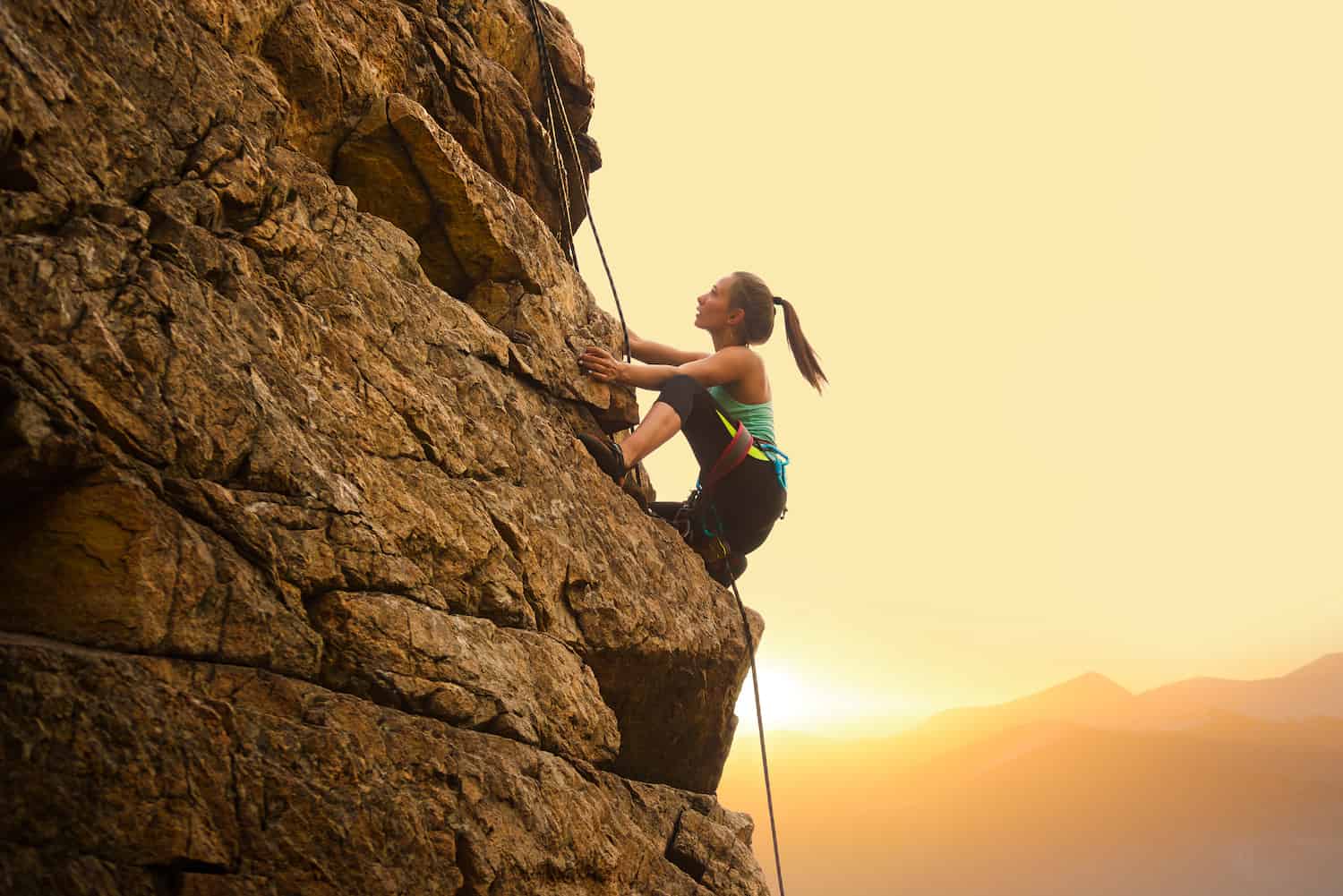
The sport of rock climbing has reached an all-time peak in popularity. There are thousands of dedicated climbing gyms in the world and thousands of more indoor climbing opportunities at recreation and fitness centers. The number of people climbing outdoors has risen in tandem. And in 2021, for the first time, climbers displayed their elite athleticism in competition at the Olympic Games in Tokyo.
In other words, rock climbing has expanded beyond its status as an esoteric, cultish sport into the mainstream. And with that, the number of new climbers beginning the pursuit has grown enormously.
Are you one of these brave souls? But also worried about whether climbing is truly safe? And whether you’ll be able to learn the proper techniques or have enough physical prowess to succeed?
The answer to all of these questions is YES!
Read on to find out how to get into rock climbing safely, maximize your enjoyment, and boost your strength, stamina, and flexibility.
Can I Start Rock Climbing If I’m Not in Top Physical Condition?
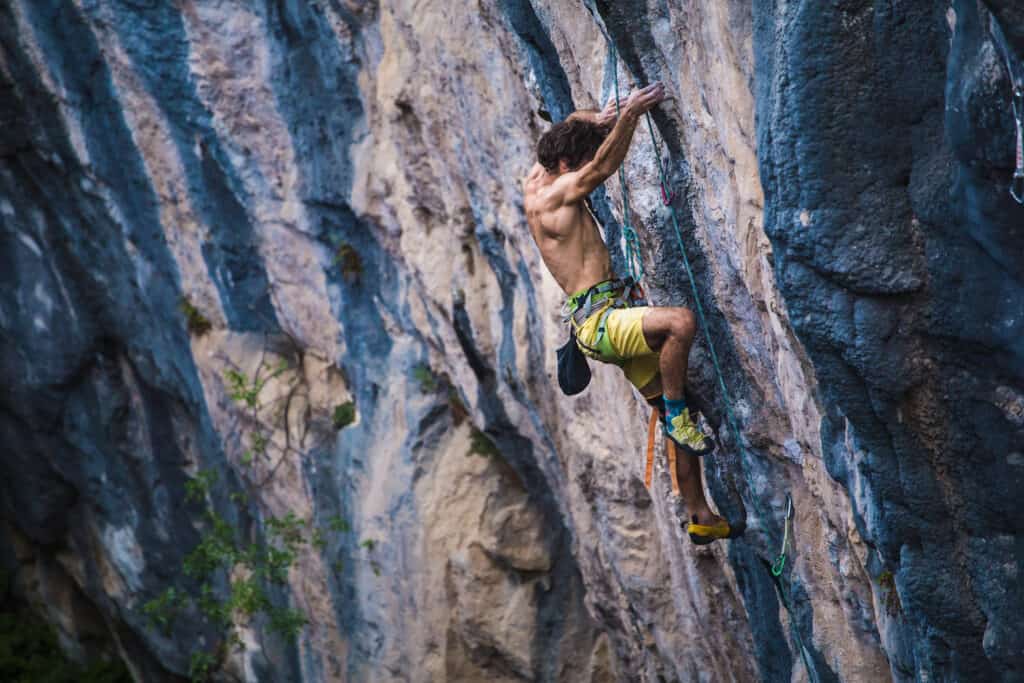
Many beginning climbers often mistakenly believe that more experienced climbers have massive upper body strength combined with absolute fearlessness!
Nothing could be more untrue. Getting to the top of a rock climb is about choosing the appropriate climbing difficulty and personal determination, not one’s athletic ability or technical mastery. And most climbers are incredibly attentive to the details of safety and injury prevention, as they should be.
New climbers start the sport from the ages of 2 to 80. There are even climbers who perform at an elite level well into their 60s. Also, there are more adaptive technologies for climbing than ever before. As a result, the benefits of rock climbing have become accessible to an even larger audience.
In conclusion, almost anyone can feel confident about getting started rock climbing. If they have the desire, there’s some type of rock climbing that will bring them joy and a full-body workout.
Indoor Gym Climbing

The majority of new climbers these days begin their journey inside. In the United States, there is at least one local climbing gym in nearly every major city. In a climbing-crazy place like Colorado, you’ll find close to twenty just in the Denver metropolitan area.
An indoor climbing gym is arguably the safest environment to learn and practice the fundamentals of the sport. The design of the floor and walls provides secure belaying and landing areas. Also, there are rules and safety protocols everyone must follow. Most (if not all) places have professional instruction available for those who need it.
How It Works
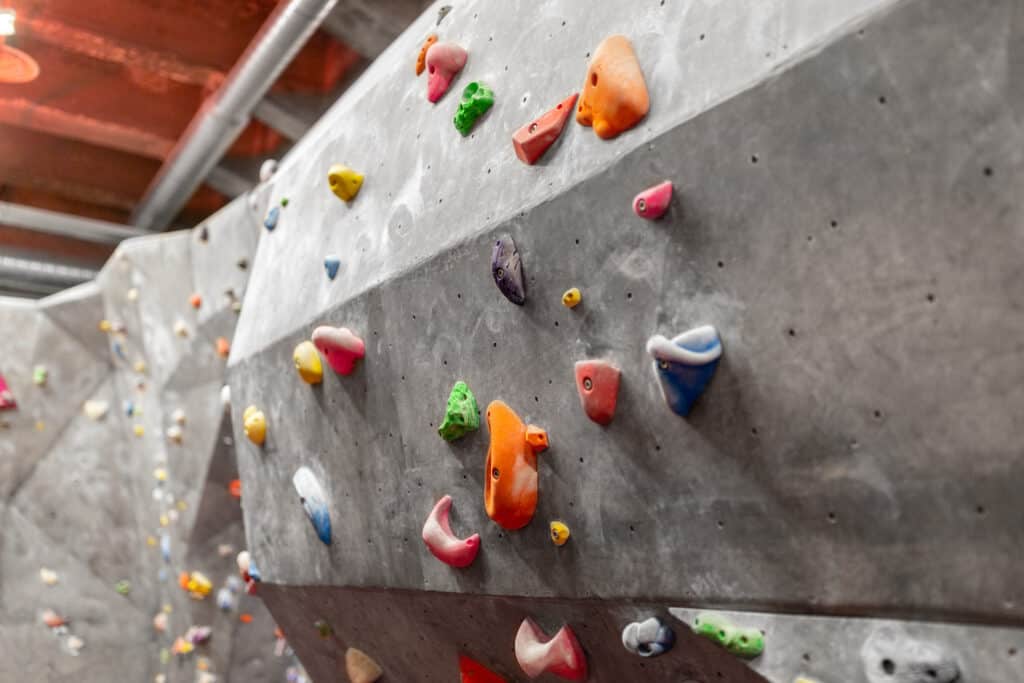
These gyms have artificial walls most often constructed with plywood sheets over metal frames. Artificial holds of different sizes and shapes are attached to the walls for climbers’ hands and feet.
The holds are moveable, and most indoor climbing gyms rotate or change their placement regularly. This way, climbers don’t get bored with the same holds in the same sequence. A specific set of holds is marked or placed using the same color to indicate a particular route you must take to ascend the wall.
Each route has an assigned grade, from easy to extremely difficult, and these climbing grades are usually displayed on the wall. This helps you decide which routes to attempt and have the best chance of reaching the top or offering you the most challenge. If you’re a beginner, you can stick to the easier climbs in the gym as you build up your skills and muscle.
Climbing Indoors for the First Time
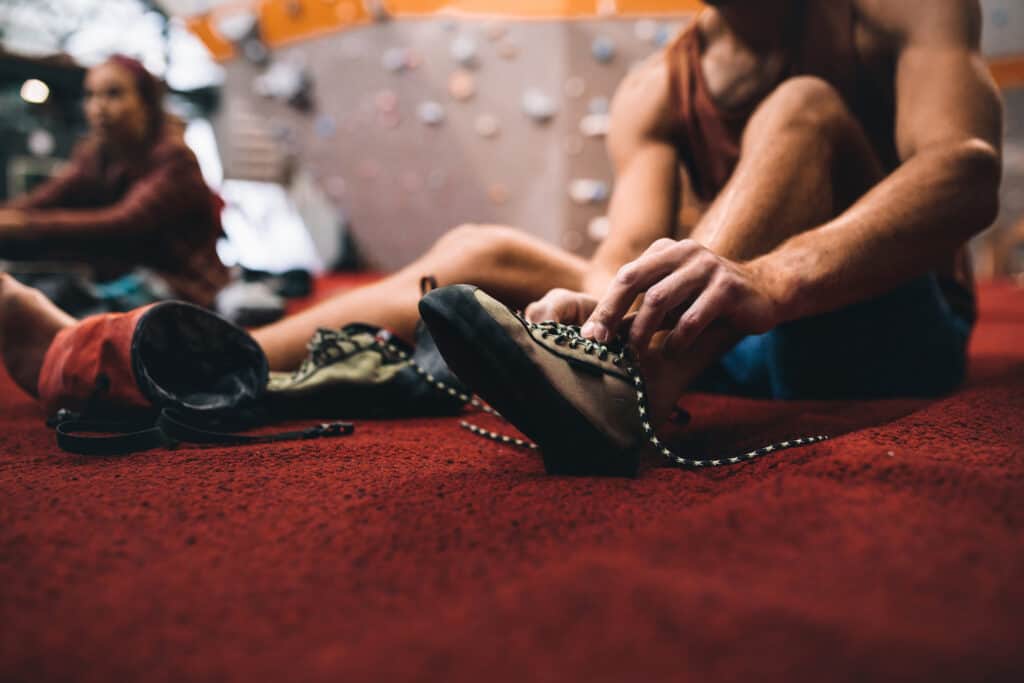
Your first visit to a rock climbing gym can be intimidating. Everyone will appear to have superhero-level abilities and know exactly what they’re doing.
Don’t worry! Most climbers are super enthusiastic about sharing what they know and how much they love rock climbing.
The great thing about starting indoors is that you don’t need to own any rock climbing gear except whatever loose, comfortable clothing you’d like to wear while climbing. You can rent shoes, a harness, a chalk bag, and anything else you might need from that facility, along with your entry fee. (See “Essential Rock Climbing Equipment” below.)
Unless you already have a trusted, experienced climbing friend, you’ll likely need to take an intro course to learn the basics of belaying, tying knots, and how to climb safely. If you have some previous knowledge or training, you’ll need to take a test to prove your abilities before tying in and jumping on the wall.
If you’re not sure, contact the gym to ask about rules, certification criteria, and whether a climbing lesson is available to teach you the fundamentals.
Before You Start
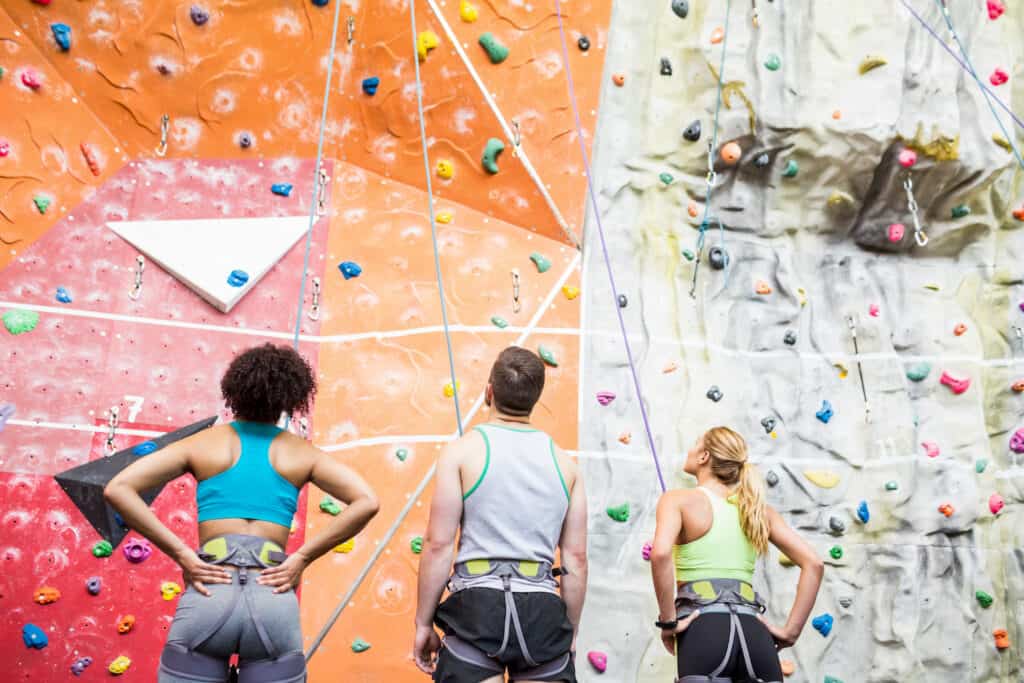
Once you have learned to put on a climbing harness, tie an approved knot, and follow the proper verbal commands between climber and belayer that most gyms require, you’re almost ready to start up your first climbing route!
You will also need to have a partner who is trained to belay. The belayer holds one end of the rope and minimizes the distance a climber falls, preventing his partner from hitting the ground!
This person can be a friend or a gym staff member. If you don’t have any friends available to be your climbing partner, inquire about hiring an employee for a belay session at the gym. Soon enough, you’ll meet other climbers seeking partners, and that will expand your possibilities.
Many climbing gyms also use a device called an auto belay. It incorporates an automated braking mechanism to slowly lower a climber back to the ground when they fall.
Indoor Top Rope Climbing
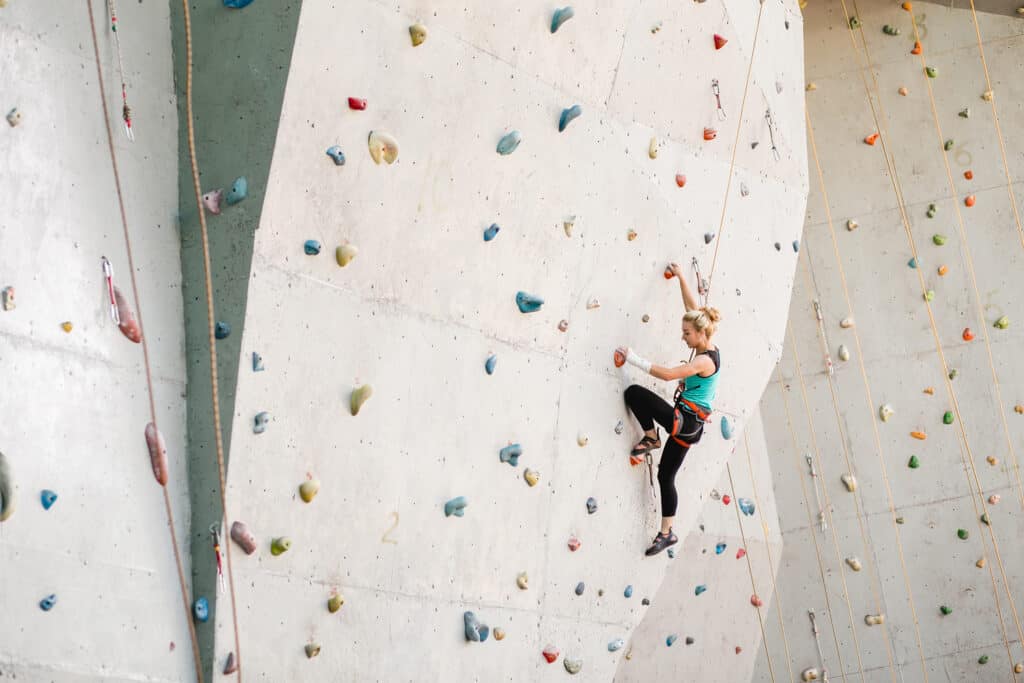
Most people start climbing with ropes using a method called top-roping. This means the rope is already anchored to the top of the wall when the climber begins climbing the route.
One end of the rope is tied to the climber. From there, it goes up and runs through some type of fixed anchor near the end of the route. The opposite end of the rope is held and managed by the belayer on the ground. This end runs through a belay device, which helps to brake and stop the rope in the event of a climber fall.
Select one of the gym’s easiest-rated routes for your first top-rope climb indoors. Generally, these climbs are less steep and have larger, more positive hand and footholds. Check your harness, knot, and partner’s belay device per safety guidelines.
As you grab onto the first holds and begin up the wall, your partner takes up slack and keeps the rope relatively taut. The belayer’s main job is to pay attention and immediately stop the rope from feeding through the system in the event of a fall. This makes top-roping the safest type of rope climbing because climbers usually only fall the distance that the rope stretches, around a couple of feet or less.
When you make it to the top of an indoor climbing route, your belayer will take up all the slack in the rope and lower you back to the ground. Congratulations!
Indoor Lead Climbing

Lead climbing is one of the other types of climbing offered in most climbing gyms. This is a form of rope climbing where the climbing rope is NOT attached to the top of the wall. The climber ties themselves into one end of the rope and secures the rope to a series of pre-installed anchors as she ascends the wall. As always, a belayer manages the other end of the rope and protects the climber using a belay device.
This style of climbing inherently carries more risks than top-roping. A lead climber clips the rope into carabiners attached to the wall as she passes. So, if she falls when 3 feet above the last anchor point, she will fall a minimum of 6 feet, plus rope stretch and any slack in the system. The farther one is above the last point of protection, the farther the distance of any potential fall.
Lead climbers routinely take falls of 5-15 feet (1.5-4.5 m) safely and without drama. Accepting the idea of falling takes practice like anything else. However, it’s an accepted part of pushing through one’s limits to reach a new level for many.
For these reasons, most climbers consider leading a more advanced technique. It’s a personal decision that every climber faces, and some start leading right away. Others may never feel comfortable with the objective risks of leading.
However, if you want to lead climb, the safest and easiest path is to start climbing indoors. After you gain skills and confidence top-rope climbing, the idea of tying into the “sharp-end” of the climbing rope and setting out will feel much less intimidating and scary!
Bouldering Indoors
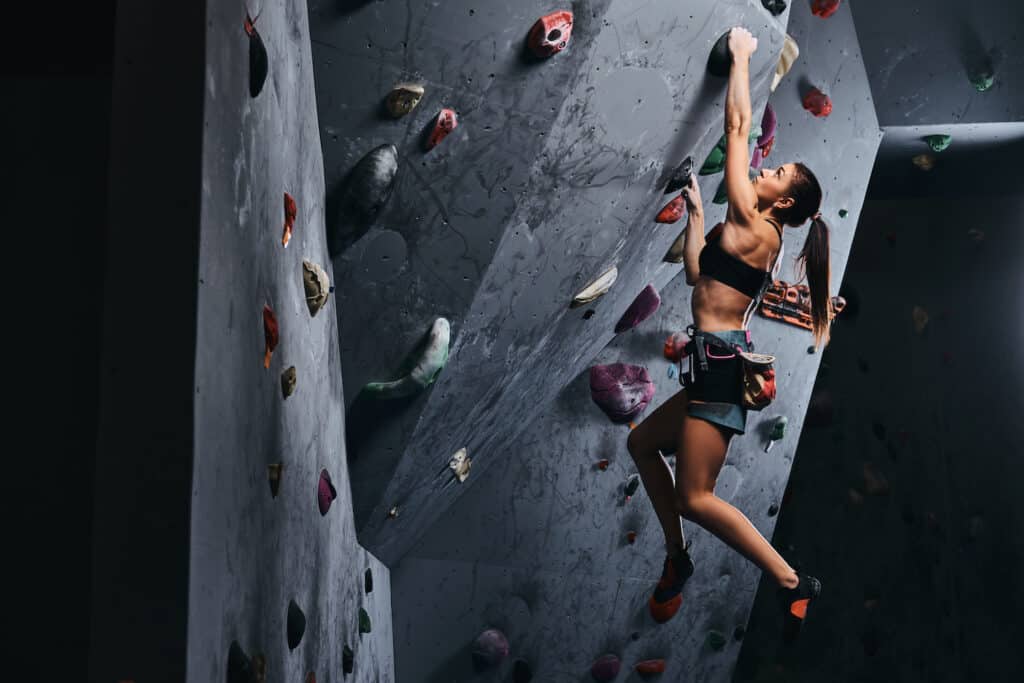
So far, we’ve only discussed climbing with ropes, but nearly every climbing gym also has an area with shorter walls that don’t have ropes anchored at the top. This unroped climbing is called bouldering.
In fact, this type of climbing is so popular that many new climbing gyms only offer bouldering, with no ropes in sight!
There are many benefits to bouldering as opposed to roped climbing. For one, you don’t need to find a climbing partner to enjoy a session.
Also, bouldering demands very little equipment: only climbing shoes and a chalk bag. Bouldering gym floors have thick, cushy padding so that it’s pretty safe to fall from high off the ground.
Is Bouldering Hard?
Bouldering routes are shorter, so they tend to be more challenging than longer routes that require climbing ropes. Most gym’s boulder areas include steep, overhanging walls and cave features that force climbers to cling to completely horizontal roofs.
Although climbers should rely more on flexibility and technique than brute strength, bouldering does tend to develop and demand more power than endurance. If you’re climbing near the top of your abilities grade-wise, each move on a boulder route should push you nearly to a maximum level of effort.
That said, today’s climbing gyms are very beginner-friendly and inclusive in the way they set routes. Their business model depends on accommodating the broadest audience and welcoming newcomers, so be assured. You will find a challenge that you can conquer!
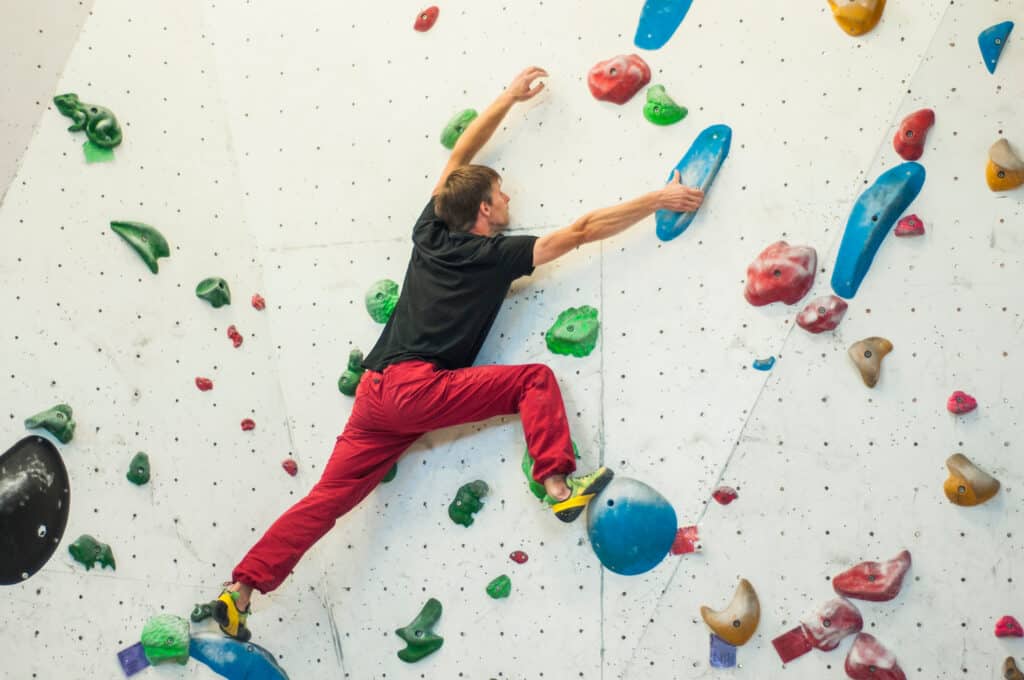
What’s Your Problem?
A bouldering route is also known as a problem. Boulderers have invented their unique scales of difficulty and climbing grades, which differ from country to country.
In the United States, most climbers use the V-scale, which currently runs from V0-V17. That means V17 is reserved for the hardest known bouldering problems in the world, of which there is only a handful. The V-scale is sometimes called the “Hueco” scale because one of the first locations it was applied is Hueco Tanks State Park in Texas, U.S.A.
The other most popular bouldering grade system, developed in France and used in most European countries, is the Fontainebleu (or Font) scale, which runs from 1 to 9a. This system takes its name after the Fontainebleu region south of Paris, a wonderland of glacier-tumbled granite blocks scattered throughout the forest.
Find Your Level
Whatever grading system your climbing gym uses, if it’s your first time, start on the lowest-rated problems you can find. Some gyms create problems that are even easier than V0.
If you discover that you are easily reaching the top of the lowest-rated climbs, move up one grade level and repeat. You’ll quickly find your ceiling where the next grade level up seems utterly impossible. Don’t worry; a few sessions for most people lead to significant progress and the ability to climb more challenging problems.
Outdoor Climbing
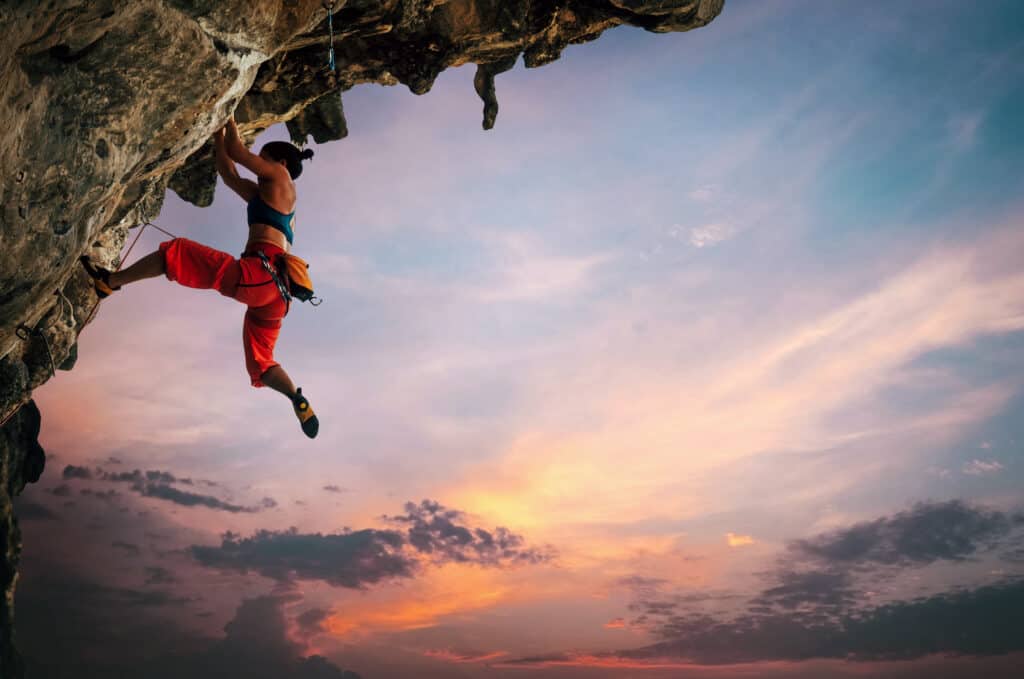
All of the different types of climbing that one can pursue indoors can also be performed outside on real rock. Of course, this is where rock climbing as a sport began. Modern climbing ethics and techniques originated in the mountains and hills of Europe, eventually influencing the rest of the world and evolving along the way.
Again, while sport is by far the style with the most participants, bouldering and traditional climbing have devoted, hardcore followings.
If you have tried different types of climbing indoors, you might know what interests you most about outdoor climbing. Short, powerful boulder moves? A low-key day of top-rope climbing outdoors while enjoying the beauty of nature? Intense, technically challenging sport routes?
Outdoor Bouldering: Rock Climbing Stripped to the Basics

The simplest and most accessible form of climbing. You don’t even need to purchase any special gear or travel to a magical destination to enjoy the childish freedom of moving your body over rock. Granted, climbing shoes and chalk will increase your potential and expand possibilities. And crash pads help you avoid injury and climb higher with greater confidence.
But that’s really all the gear you’ll ever need for a lifetime of bouldering. There are small blocks and rock outcroppings all over the world that are suitable for bouldering. Most boulder problems are in the 8-12 feet (2-4 m) tall range, but highball problems can reach up to 15-20 feet (4.5-6 m) or taller!
If you want to boulder at a high level, it’s best to find a couple of partners who can spot your falls and carry more crash pads into the woods, but you can have amazing sessions all by yourself if necessary.
Outdoor Roped Climbing

Sport climbing, as we mentioned above, includes both top rope and lead climbing. There are thousands of crags around the world where climbers have installed semi-permanent hardware into the rock. This hardware mainly includes bolts for lead climbers and bolted anchors at the end of routes or at belay stations on multi-pitch climbs.
The easiest type of climbing to start on outside is top-roping. It takes a minimal equipment and knowledge to set up a top rope. Just realize that to top rope outdoor climbs, you will need to have access to the top of the climb so that you can get your rope anchored safely.
If your goal is to start your climbing outdoors, it’s strongly recommended that you find an outdoor guiding service or ask a highly experienced climber to take you out. Real rock’s variable conditions and unforgiving nature make outdoor climbing more hazardous than a controlled, indoor environment.
Aside from the increase in objective risks, the mechanics of outdoor climbing are very similar to indoors. However, there are critical differences and additional techniques that you’ll need to learn to climb safely. How to clean your gear from the anchors when you finish a climb, and how to rappel to the ground, for example.
Simply because you have mastered all aspects of indoor climbing, don’t be lulled into thinking yourself an expert if you haven’t climbed outside. Take your time and learn the differences, and a world full of new challenges and natural beauty will become open to you!
All Rounder or Specialist?
Some climbers prefer one type of climbing over others to the extent that they exclusively choose to boulder or sport climb.
Other people like to vary their experience and enjoy all of the different routes in the gym, from boulders to top ropes to lead climbs. There’s no one best style or format (no matter what trad climbers might say!).
Environmental Awareness

As with all outdoor athletes, as climbers, we need to maintain a high level of ecological awareness regarding our favorite places and the impacts we create.
That means not only picking up all of one’s rubbish but also not creating networks of unofficial trails, leaving chalk marks behind, or allowing dogs to run rampant while their owners are occupied. Minimize any damage or alteration to the rock wall, mosses, lichens, and other plant and animal life you encounter.
Those are just a few examples of poor social and environmental etiquette. Most climbers are fairly forgiving, so if you don’t know what to do, observe, don’t set anything on fire, and you should be fine.
Rest for Success
First-timers who are excited about climbing sometimes make the mistake of being too enthusiastic. They charge at one problem after another until, 20 minutes later, they realize they can’t grip even the largest holds without muscle failure.
So even if you’re tackling problems well within your ability, take a break between every few attempts, at least. You’ll be surprised how much your body can recover with a drink and five minutes of rest.
Similarly, climbing can be quite tough on your hands in the first weeks, until your skin hardens and grows calluses. Blisters and scratches are quite common for beginners (and even for more advanced athletes). Wear them as a badge of honor, and, of course, treat and protect them so that they don’t ruin your climbing experience.
Last but not least, as with any sport, make sure you take time to recover in between climbing sessions. It’s highly recommended to rest at least one day between each session to let your body rest and get stronger over time. Later on, you should be able to climb 4-5 times a week without issues.
Alex Lowe (1) once famously said:
The best climber is the one having the most fun.
And the one who doesn’t get injured, we may add. Just don’t rush, and enjoy!
Essential Rock Climbing Equipment
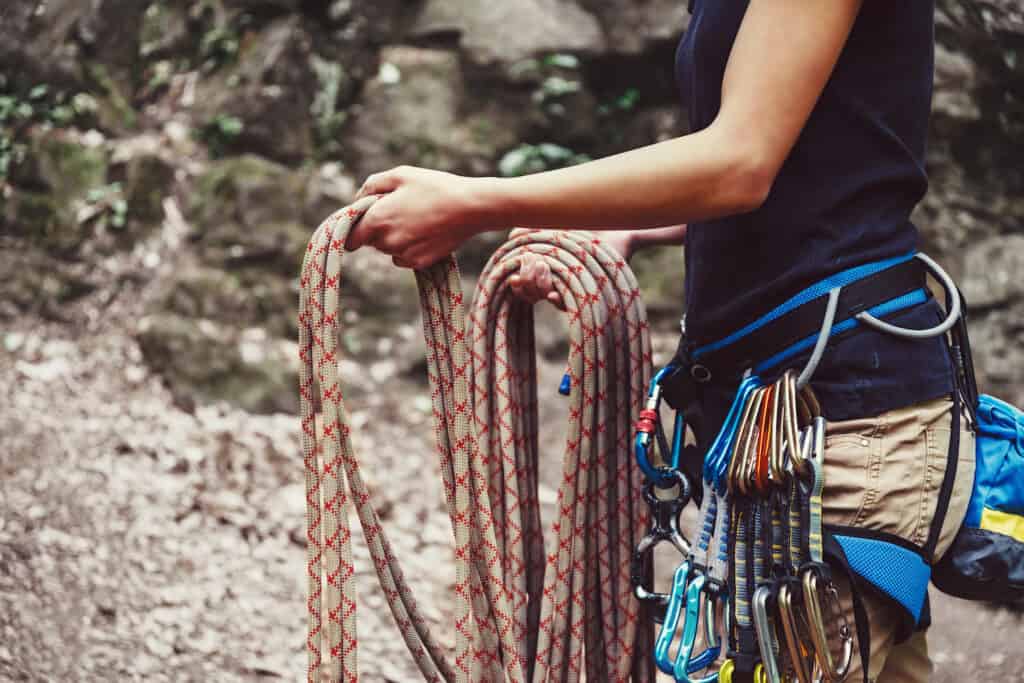
The following lists summarize the gear and equipment you’ll need for the various rock climbing methods described in this article.
Bouldering (Indoors)
- Climbing shoes – Some climbers have a preference for ultra-tight shoes, but as a beginner, you should aim for comfort before performance. Find climbing shoes you can wear for an hour without pain.
- Loose chalk and bag – You don’t need anything fancy. Pick a color you like and whatever chalk you can find and afford. Liquid chalk is a better option for gym climbing and can also act as an effective base layer when outdoor climbing.
Bouldering (Outdoors)
- Same as indoors, plus…
- Crash pad(s)
Top Rope Climbing (Indoors)
- Climbing shoes
- Climbing harness – A climber’s harness has a big impact on comfort. However, beginners should choose a lower-priced harness from a reputable brand, or rent one at the gym until you’re ready to invest in your own gear.
- Belay device – Some gyms require assisted braking devices (the Petzl Gri-Gri, for example), others allow you to bring whatever you’re comfortable with. Make sure you ask.
- Locking carabiner – A locking carabiner is used to attach a belay device to the belayer’s harness.
Lead Climbing (Indoors)
- Same as top rope gear, plus…
- Climbing rope – Some gyms allow climbers to bring their own rope, some provide ropes for leading. If you only plan to climb in the gym, you might find a shorter rope length is sufficient for that venue.
Top Rope and Lead Climbing (Outdoors)
- Same as lead climbing gear indoors, plus…
- Climbing helmet – A helmet is advised not only to protect a climber’s head during a fall, but to protect the climber and belayer both from natural and human-caused rockfall.
- Quickdraws – A quickdraw consists of two carabiners connected by a fabric sling. A lead climber clips one side to a bolt in the rock and clips the rope through the other to protect leader falls. Typical sport climbing routes generally require 6 to 15 quickdraws to protect an entire route.
- Personal anchor system – A type of fabric sling or daisy chain that attaches to a climber’s harness and provides a secure point for a climber to clip themselves to an anchor and take weight off the belay system. This is required to clean a route’s anchor after climbing.
- Gear to make anchors – Setting up a top rope requires some form of anchor system. There are various methods, but one of the simplest is to use four locking carabiners and two long slings.
- A stick clip can also be useful to reach the first bolt safely.
Are you confused by some of the climbing terms? Check out this neat guide with all the important lingo in one place.
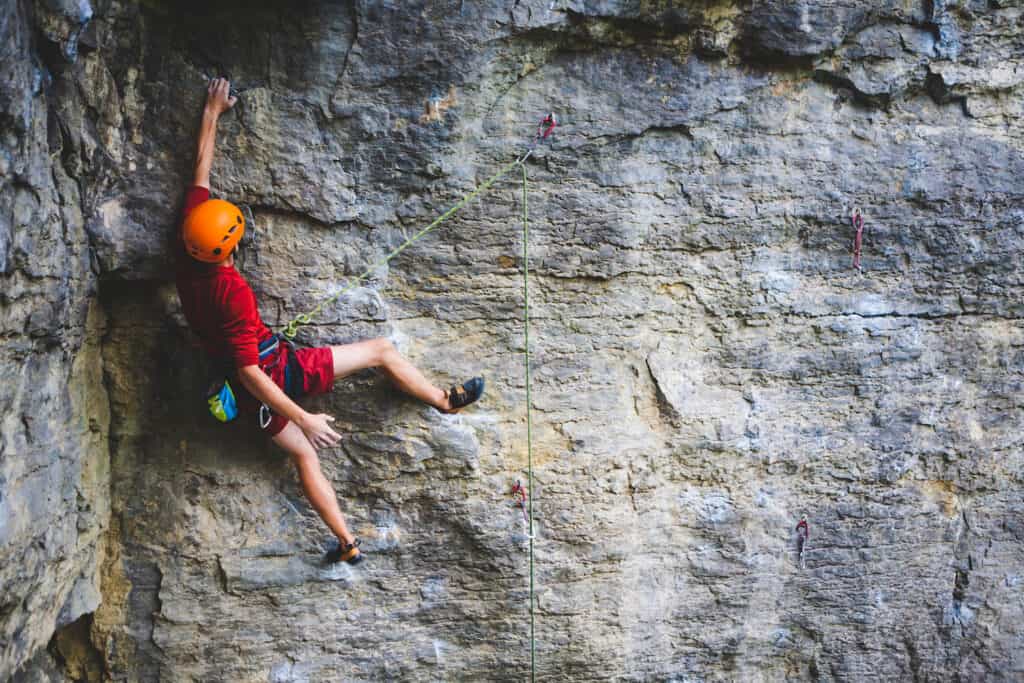
Frequently Asked Questions (FAQs)
When you use a climbing rope to protect yourself from falling, without using the rope in any way to aid your ascent, that’s technically free climbing. When you free climb by top rope climbing OR lead climbing using pre-placed bolts or anchors for protection, those styles are known as sport climbing.
Sport climbing with ropes, both indoors and outdoors, is the most popular form of climbing worldwide. It’s relatively safe and accessible to a wide range of physical makeups and body types.
There is one other significant style of rock climbing, but it’s rarely if ever, practiced indoors. This is traditional climbing, more commonly called trad climbing.
Trad climbing requires a leader to place their own gear to protect from falls, rather than relying on existing hardware that is bolted to the wall or rock. These pieces of gear, or protection, include oblong chunks of metal called nuts that trad leaders wedge into cracks and the spring-loaded camming device that actively pushes against the insides of a crack to provide greater fall security.
The neat thing about trad climbing is that any appealing crack in a rock face is a potential trad route! And it leaves less impact on the earth since leaders don’t use bolts for protection.
While traditional climbing begat all the other types of climbing, higher perceived risk by most people makes this the least popular and most “difficult” of the major three styles of rock climbing (sport, trad, and bouldering).
References:
